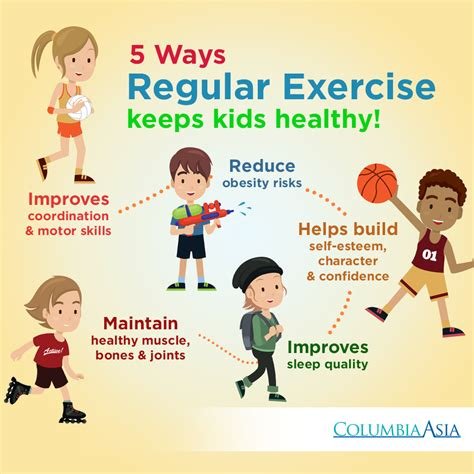The Benefits of Physical Activity for Kids: Fun Ways to Keep Children Active
As parents, we all want the best for our children, and that includes ensuring they lead healthy and active lifestyles. Encouraging our kids to engage in physical activity not only promotes good physical health but also plays a crucial role in their cognitive and social development. In this blog post, we will explore the various benefits of physical activity for children and discuss fun and engaging ways to keep them active. From the importance of physical activity for kids to incorporating exercise into their daily routines, we will cover it all. Join us as we delve into the role of exercise in cognitive development, explore fun outdoor activities, and discover how to make exercise enjoyable for kids. Additionally, we will discuss the social benefits of physical activity for children and share strategies to motivate them to stay active. Let’s create a supportive environment that encourages our kids to lead active and healthy lives!
Importance of Physical Activity for Kids
Physical activity is crucial for the healthy growth and development of children. It not only helps them maintain a healthy weight, but also builds strong bones and muscles, improves cardiovascular fitness, and promotes overall well-being.
Regular exercise also plays a significant role in preventing chronic diseases such as obesity, diabetes, and heart disease, setting the foundation for a healthier future. Additionally, physical activity helps children improve their balance, coordination, and flexibility, reducing the risk of injury during other physical activities and sports.
Aside from the physical benefits, exercise has a positive impact on children’s mental health, helping them reduce stress, improve mood, and boost self-confidence. It also promotes better sleep patterns, which is essential for their overall health and well-being.
Encouraging children to engage in physical activities from a young age promotes healthy habits that they can carry into adulthood, leading to a lifetime of better health and wellness. It is important for parents and caregivers to prioritize and support their children’s physical activity to ensure their long-term health and well-being.
Benefits of Physical Activity for Children’s Health
Physical activity plays a crucial role in maintaining and improving children’s overall health. Engaging in regular exercise not only helps children stay fit, but it also contributes to their physical and mental well-being.
One of the major benefits of physical activity for children’s health is the prevention of obesity. Regular exercise helps children maintain a healthy weight and reduces the risk of developing obesity-related health issues such as type 2 diabetes and heart disease.
Furthermore, physical activity is essential for the development of strong bones and muscles in children. Engaging in activities such as running, jumping, and playing sports helps improve bone density and muscle strength, which are important for overall physical development.
Moreover, regular physical activity also has a positive impact on children’s mental health. It helps reduce symptoms of anxiety and depression, improves mood, and enhances cognitive function, leading to better academic performance.
Role of Exercise in Cognitive Development
Exercise plays a crucial role in the cognitive development of children. When kids engage in physical activity, they not only build strong muscles and bones, but they also boost their brain power. Studies have shown that regular exercise can improve cognitive function, attention span, memory, and academic performance in children.
Physical activity can stimulate the release of chemicals in the brain that affect the health and growth of brain cells, which in turn can enhance a child’s cognitive abilities. It also helps in developing important skills such as problem-solving, decision-making, and concentration, which are essential for academic success.
Furthermore, exercise promotes better sleep quality, reduces stress, and enhances mood, all of which contribute to improved cognitive abilities. It also fosters a sense of discipline and perseverance in children, which are valuable traits for their overall development.
It is important for parents, educators, and caregivers to recognize the significance of physical activity in cognitive development and incorporate it into the daily routines of children. Whether it’s through active play, sports, or simply taking a walk, encouraging kids to be physically active can have a lasting impact on their cognitive abilities.
Fun Outdoor Activities to Keep Kids Active
When it comes to keeping kids active, there’s nothing quite like getting outside and enjoying the fresh air. Outdoor activities not only provide physical exercise, but they also allow kids to explore their creativity and imagination. One fun outdoor activity to keep kids active is a nature scavenger hunt. This can be as simple as creating a list of items to find in the backyard or at a local park, and letting the kids loose to explore and hunt for the items. This not only encourages physical movement, but also engages their senses and observation skills.
Another great way to keep kids active outdoors is by setting up a mini obstacle course. This can be done using items like hula hoops, cones, and jumping ropes. The kids can race against each other or time themselves as they navigate through the course, providing both physical and mental challenges. Additionally, engaging in team sports such as soccer, basketball, or tag can keep kids active while also encouraging social interaction and cooperation.
One classic favorite outdoor activity is flying a kite. Not only is this a fun and relaxing way to spend time outside, but it also requires kids to move around as they run and control the kite. This simple yet enjoyable activity provides both physical and mental stimulation while enjoying the great outdoors. Lastly, going for a nature hike is a fantastic way to keep kids active. Whether it’s a short walk around the neighborhood or a hike in a nearby trail, exploring the outdoors can provide countless opportunities for physical activity and discovery.
Overall, keeping kids active through fun outdoor activities is essential for their physical and mental well-being. By incorporating these activities into their routine, children can develop healthy habits and a love for being active in the great outdoors.
Engaging Indoor Games for Active Playtime
When the weather isn’t ideal for outdoor play, it’s important to have a variety of indoor games and activities to keep kids active and entertained. Engaging indoor games can help promote physical activity and active playtime, even when kids are stuck inside.
One fun indoor game that promotes active play is a scavenger hunt. Create a list of items for kids to find around the house and set them loose to hunt for the items. This not only gets them up and moving, but also encourages problem-solving and critical thinking skills.
Another engaging indoor game is a dance party. Turn on some upbeat music and encourage kids to dance and move their bodies. Dancing is a great way to get exercise and have fun at the same time, and it’s a perfect activity for an indoor playtime.
For a more structured activity, consider setting up an obstacle course in the living room or playroom. Use pillows, furniture, and other household items to create a fun and challenging course for kids to navigate. This not only gets them moving, but also helps improve balance, coordination, and agility.
Incorporating Physical Activity into Daily Routines
It’s important to incorporate physical activity into daily routines to promote a healthy lifestyle for children. By making it a regular part of their day, kids will develop good exercise habits that they can carry into adulthood. Whether it’s a walk to the park, a game of tag in the backyard, or a family bike ride in the evenings, finding opportunities for physical activity throughout the day is crucial.
One way to incorporate physical activity into daily routines is by making it a part of family time. Instead of watching TV or playing video games, encourage active playtime by going for a family hike or playing a game of soccer in the yard. By engaging in these activities as a family, not only are children getting exercise, but they are also spending quality time with their loved ones.
Another way to include exercise into daily routines is by making it a part of the daily commute. If it’s safe and feasible, consider walking or biking to school or work rather than driving. Not only does this provide an opportunity for physical activity, but it also reduces carbon footprint and promotes environmental awareness.
Additionally, parents and caregivers can set a good example by being active themselves. When children see adults engaging in regular exercise, they are more likely to follow suit. Whether it’s going for a run, taking a fitness class, or even just stretching at home, showing kids that physical activity is a priority can have a lasting impact on their habits.
How to Make Exercise Fun for Kids
Exercise is important for kids to stay healthy and develop good lifestyle habits. However, getting children to willingly engage in physical activity can sometimes be a challenge. But there are some ways to make exercise more enjoyable for kids, ensuring they stay active and healthy.
One way to make exercise fun for kids is by incorporating games and activities that they enjoy. Whether it’s playing tag, jumping rope, or having a dance party, turning physical activity into a game can make it more appealing to children. This not only gets them moving, but also helps them to develop important motor skills and coordination.
Another way to make exercise enjoyable for kids is by involving them in choosing the activities. When kids have a say in what physical activities they want to do, they are more likely to be engaged and enthusiastic. This can also help them feel a sense of autonomy and control over their own health and well-being.
In addition, making exercise fun for kids can involve turning it into a family activity. When parents and other family members participate in physical activities with their kids, it not only promotes a healthy lifestyle for everyone, but also provides quality bonding time. This can encourage and motivate kids to stay active and view exercise as a positive experience.
The Social Benefits of Physical Activity for Children
Physical activity is not only good for a child’s physical health, but it also provides a multitude of social benefits. When children engage in group physical activities, whether it’s playing team sports or going on a group hike, they are given the opportunity to develop important social skills. They learn how to work as a team, communicate effectively, and build friendships through shared experiences.
Participating in physical activities also allows children to develop a sense of belonging and inclusion within a group. Whether they’re part of a dance class or a soccer team, they feel a sense of camaraderie with their peers, which can improve their self-esteem and confidence. This feeling of being part of a community can have a positive impact on their overall well-being and mental health.
Furthermore, physical activity can provide children with opportunities for leadership and cooperation. Through group activities, children learn valuable leadership skills, such as taking initiative, making decisions, and guiding others. They also gain an understanding of cooperation and the importance of working together to achieve a common goal.
Overall, the social benefits of physical activity for children are numerous and play a crucial role in their overall development. By engaging in group physical activities, children not only improve their physical health but also develop important social skills, a sense of belonging, and the ability to work effectively with others.
Strategies to Motivate Children to Stay Active
As a parent, it’s important to prioritize the physical activity of your child. With the rise of technology and sedentary lifestyles, getting children to stay active can be a challenge. However, there are several strategies that can be implemented to motivate children to engage in physical activities.
One effective strategy is to lead by example. Children are more likely to engage in exercise if they see their parents and role models doing the same. Taking the time to participate in physical activities as a family not only promotes a healthy lifestyle but also encourages children to follow suit.
Another effective way to motivate children is to make activities fun and enjoyable. Incorporating games, sports, and outdoor activities that children find exciting and engaging can make them more willing to participate in physical activities.
Additionally, offering rewards and incentives can be a great motivator for children. Whether it’s a trip to their favorite park, a new toy, or a special treat, providing positive reinforcement can encourage children to stay active and continue engaging in physical activities.
Creating a Supportive Environment for Physical Activity
Creating a supportive environment for physical activity is crucial for children’s overall health and well-being. As parents and caregivers, it is our responsibility to provide children with the opportunities and resources they need to stay active and develop healthy habits.
One way to create a supportive environment is by leading by example. When children see their parents or caregivers being physically active, they are more likely to follow suit. Whether it’s going for a family walk, playing in the park, or participating in sports together, being active as a family sends a powerful message to children about the importance of physical activity.
Another key aspect of creating a supportive environment for physical activity is providing access to safe and engaging spaces for children to play and be active. This could involve setting up a play area in the backyard, taking children to local parks or playgrounds, or enrolling them in organized sports or activities. By ensuring that children have access to these opportunities, we can encourage them to be more active on a daily basis.
Additionally, it’s important to limit sedentary activities such as screen time and encourage physical play instead. By setting clear guidelines around screen time and providing alternative activities, children can be more inclined to choose active play over sedentary behaviors.
Frequently Asked Questions
Why is physical activity important for kids?
Physical activity is important for kids because it helps in the development of muscles and bones, reduces the risk of chronic diseases, and improves their overall physical and mental well-being.
What are the benefits of physical activity for children’s health?
Physical activity helps in maintaining a healthy weight, improves cardiovascular health, boosts immune system, and reduces the risk of developing health problems such as diabetes and obesity.
How does exercise contribute to cognitive development in kids?
Exercise helps in improving concentration, attention, and memory in kids. It also enhances their creativity and problem-solving skills.
What are some fun outdoor activities to keep kids active?
Outdoor activities such as cycling, swimming, hiking, and playing sports like soccer and basketball are great ways to keep kids active and engaged.
What are some engaging indoor games for active playtime?
Indoor games such as treasure hunt, dance party, obstacle course, and yoga are fun and active ways to keep kids moving inside the house.
How to make exercise fun for kids?
You can make exercise fun for kids by incorporating music, using colorful equipment, organizing group activities, setting up challenges, and offering rewards for participation.
What are the social benefits of physical activity for children?
Physical activity helps in building social skills, fostering teamwork, and creating a sense of belonging and community among children.
How can parents motivate children to stay active?
Parents can motivate children to stay active by being good role models, offering positive reinforcement, creating a supportive environment, and involving them in the decision-making process.






